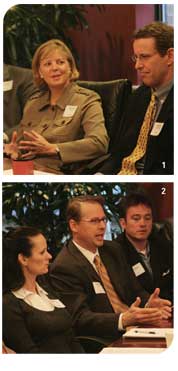“For example,” said Stephenson, “all these sidewalks on the Plaza are public sidewalks, and we redo them ourselves. Can you imagine what they would look like if the city redid the sidewalks?”
One reason for the defensiveness around the table is the perception that the media have failed to explain the tax incentive process to the area’s citizens.
“[Citizens] all think it is something that is going to come out of their pockets,” said Julie Jurden with RED Development. She noted too the media are much more eager to expose the abuse of a TIF than “the great things that it is going to create for the city.” Jurden saw not so much intentional bias as a failure of understanding.
“It’s hard to discuss TIF with some-body,” agreed Tom O’Leary, adding that although the public tends to think that it’s “free money,” it is decidedly not.
Destination Projects
Destination/entertainment projects seem to be flourishing in Kansas City, Dan Lowe suggested. The Legends, which RED develops, certainly qualifies, as does the Country Club Plaza. The Bass Pro complex in Eastern Jackson County has tagged itself as a destination/entertainment project as well.
“What in your mind makes up a destination/entertainment project?” Lowe asked his colleagues. “And are all these on the table going to get built, and if so, will that be too much for Kansas City?”
“I think the Village West project has really set a high bar for everyone else who is trying to compete,” said Nathan Vanice, especially given its 8 to 10 million annual visitors.

1: Julie Jurden of RED explores the complexities of TIF and the importance of educating the public. 2: Tom O’Leary of LANE4 discusses challenges associated with assembling land for redevelopment. Lynn Best and Louie Skizas observe.
Although Kansas City does have the luxury of excellent interstate access from other regional metros, he caution-ed that “just because you put [a destination project] on paper doesn’t mean it’s going to work.”
As Bill Schultz with RED Development affirmed, the lack of population density in the area leads to a relative lack of daytime traffic even at a successful project like the Legends. “We suffer a little because we only have X people spread over a lot of district and a lot of people vying for their bucks and their time. So, it’s a real challenge.”
One reason that Oak Park Mall has decent day time traffic, attested Jody House, is that it draws from all over the metropolitan area.
“I think one reason our suburban mixed-use developments haven’t really taken off,” added Kevin Nunnink, “is
that we have such a wonderful transportation system.” With land so in- expensive and accessible there is little reason to consolidate projects.
Lynn Best of Applebee’s International asked whether the proposed Schlitterbahn water park would qualify as a destination project. Although Vanice felt it would, Lowe wondered if the area could support the additional half million square feet of retail associated with the Schlitterbahn project. Best added that a casino had also been proposed for the project, but that it is still very much on the drawing board.
As the granddaddy of all destination projects, the Country Club Plaza is perpetually “refreshing” itself, so explained Glenn Stephenson. “There is still an element we are missing here on the Plaza that downtown is bringing,” said Stephenson. “And that is [what do you do] after you eat?”
As Stephenson observed, “Retail is all about change.” He pointed out that from 1988 to 1998, 113 tenants left the Plaza, and he challenged those in the room to name more than a handful of them. As he explained, the Plaza’s real competition comes not from the people in the room but from Des Moines, Lincoln, and Omaha, which is why the Plaza pursues tenants not found anywhere else in the central Midwest.
Bob Johnson asked where tourists went when they came to Kansas City. Stephenson noted that roughly 44 percent of the Plaza’s business comes from tourists and it has not fallen off with the emergence of Village West.
Dan Lowe suggested that there was a good deal of “cross-traffic” among the destination sites. The average Legends visitor, according to a recent survey, travels 82 miles one way to get there. It is altogether likely, he added, that they will go someplace else in the metro when they are here.
(...continued)